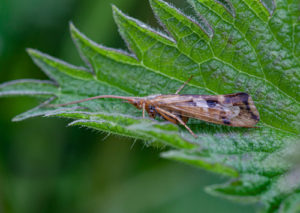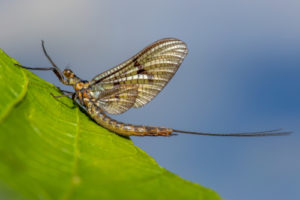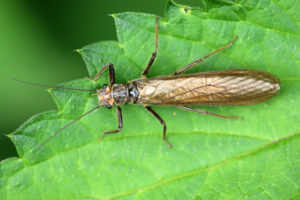If you are a beginning trout angler, you might have read or heard something about the aquatic insects that trout feast upon. Contrary to neophytes’ general belief that trout eat Royal Wulffs and House and Lots, trout only find those flies similar to their favorite food of mayflies, caddish-flies and stone-flies. And half the time, just as with lures, fancy-looking flies catch the eyes of the angler more than the trout.
You will find in books that these common aquatic insects have been given fancy scientific names. The study of these insects is called entomology. Pretty high-fallutin’ huh? Learning Latin names doesn’t make you catch more trout. Learning the stages of the insects the trout eat will help you catch more trout. It never hurts to learn all you can but at least start with the basics.
Flies usually don’t look exactly like the insect you are trying to imitate. They are imitative, suggestive, impressionistic. They look kind of like one of the insects trout eat. They look kind of like a stage of one of the insects trout eat. They provide the proper silhouette or shade or wing pattern or size or color of the insects trout eat. But they rarely look exactly like the insect.
The most abundant insects that a trout eat, are the insects that you will be imitating with your selections of dry flies, wet flies and nymphs are mayflies, caddish-flies and stone-flies. You can find the first two in almost any trout stream and stone-flies in many of them. The life cycles of each insect vary in length and process but in general, you will be trying to imitate the stages of the cycles whether the winged adult or the immature pupa.
The most successful insect baits

Caddisflies: (these belong to the Scientific Order Trichoptera) These tent-shaped adults are distinctive with their skittering flying pattern. Unlike mayflies, the caddis has no nymph form. Their stages are the egg (which won’t concern the flyfisherman), larva, pupa and adult.
In the immature phases, the caddish larvae looks like a tiny grub, a wormy little thing. These larvae build houses of twigs, rocks and other debris and sediment in which they live, usually attaching themselves to rocks or other underwater structure. Trouts find these cased caddis cocoon cuisine irresistible. This comes in handy when you are selecting an underwater fly to imitate them.
The larvae matures into a pre-adult phase, the pupa. The pupa emerges from the case and swims (rises) quickly to the surface to hatch into an adult.

Mayflies: (Of the Scientific Order Ephemeroptera) The ubiquitous mayfly. Found everywhere. Upright wings. The mayfly has a short life cycle consisting of egg, nymph (larva) and adult.
The mayfly larva tends to live in soft bottoms but can be found in rocky places as well. Generally though, silty areas are loaded with them. There are many species of mayflies, some 700. The nymphs, which are next to impossible to see, live out their time before becoming duns (the pre-adult phase) by burrowing, clinging or crawling. These larvae usually have three tails. The duns sheds its skin (and is vulnerable to trout at that time) as it prepares to leave the water and hit the sky.
The repeated dipping of an insect to the water is a surefire sign of a mayfly laying eggs on the water surface. The mayfly adults die shortly after they lay eggs.

Stoneflies: (These belong to the Order Plectera) The stonefly is a clumsy, prehistoric-looking flying creature, more suited to a bad Japanese monster movie than the scenic stream. Stoneflies fly as erratically as my grandmother drives.
The adults are flat and long with great wings that when not in use, lay down on their body. You may hear these called salmonflies but those are particular species of the order. The adults can range in color from brown to black to golden to orange.
The life cycle of the stonefly is mostly on land— egg, nymph and adult. Keep your eyes open, you can see the nymphal shucks on tree limbs, rocks, logs where the adults have crawled out onto the shore. Stoneflies tend to like faster water, rocks, boulders, overhanging trees.
You will see the stonefly’s peculiar flying pattern if you see an insect as big as a small bird dipping and diving, sputtering and coughing and buzzing then splatting on the water. That’s a stonefly.
Other wiggly or slimy things trouts get to eat
Other trout, Midges, Tricos, crustaceans such as snails, mysis shrimp and freshwater shrimp, dobsonflies, craneflies, caterpillars, leeches, dragonfly, worms, annelids, damselfly, terrestrials like grasshoppers, beetles, ants, crickets, and baitfish. Just to name a few.
One of the most important ways to learn about the insects trout eat is not from this article or from a book but on the stream. Next time you go trout fishing, take time to sit a spell along the river, looking at the trees for insects buzzing about. Pick up rocks from the streambed, turn them over and see what wigglies are crawling about. You will see the cases of the caddisfly attached to the stone. Or maybe you will see the tiny larva scurrying about on the slime of the rock. Sometimes you can see both. If it is a rocky river, you can look at the dry side of big streamside boulders for crawling stoneflies or their dry shucks they left behind. You can also see the same on streamside willows.
Often, beginning anglers see trout rising in the river but never stop to take the time to see what the fish are rising to. That’s where a seine net comes in handy. Shuffle your feet above the net, holding the net against the current. Then carefully lift the net out of the water, take it to the bank and sit down and learn. You’ll be amazed by the variety of insects the net traps, insects you never would see otherwise.
Another trick to try when the trout are rising is to capture the insect flying about in the air. These insects might be dipping up and down and you think you remember from this article and the books you read, that these insects just might be mayflies. Use your cap to snag one and study it. You can get a better gauge of the size and coloring of the insect so as to better imitate it. Seeing these insects firsthand can help you understand how to better match the hatch in the future, to understand the life cycles of the insects and how the trout tend to see the insects. And in the end, whether you learn Latin or not, you’ll catch more trout.






